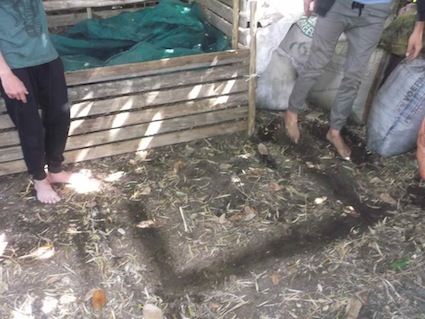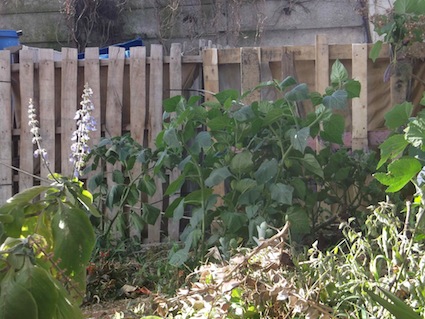Dear Reader, in this age of AI created content, please support with your goodwill someone who works harder to provide the human-made. Sign up in the righthand column or bottom of this page. You will receive my hand illustrated monthly newsletter RESTORE NATURE and access to the biodiversity garden design course as I write...and nothing else, I respect your time.
organic garden fertilizer
made the natural way in permaculture

many hands make light work during the production of organic garden fertilizer on a permaculture design course
If you want to make organic garden fertilizer its hard to do better than this rich compost as prepared by the permaculturist Karen Parkin.
We were given this demonstration on composting by Karen Parkin at a recent permaculture design course in Noordhoek, Cape Town, run by Alex Kruger and Tahir Cooper.

toeing the outline of the heap-to-be in the dust
As you will see in other articles on hot composting and aerobic composting on this website, for the process to generate heat, you need the correct Carbon-Nitrogen ratio. Karen explained that it is the Nitrogen which fuels the heat releasing reactions. She then taught us via actual practice how to construct a compost heap, with layers of straw, comfrey, manure and kelp repeated again and again, kept neat and square until we had a large cube of compostable material at least a metre by a metre by a metre, which is needed to conserve enough heat within. We then rammed a sharp wooden stick into the heap to see how warm it was. For days it would emerge steaming !

Josh puts down the first layer of straw

Jordan helps add a layer of comfrey

next comes the layer of manure

and nathaniel tops this with chopped kelp

bianca adds the next layer of comfrey and the various layers are repeated again and again

smoothed out by many hands, till the heap is a metre high

a triumphant KAREN PARKIN WITH PERMACULTURE STUDENTS BIANCA AND JORDAN AND THE STAR OF THE SHOW, A BEAUTIFUL salon worthy HEAP
I would like to emulate this process at home. I’ve acquired some lovely pallets which are fastened together with cable ties and lined with the canvas from an old tent that was left on my front porch by an unknown person for some time.

double chambered bin made of pallets for making organic garden fertilizer or compost, as seen from the garden
I have neither straw, kelp nor comfrey at the moment, but I do have different kinds of manure, one of the most important ingredients in organic garden fertilizer like hot compost. To supply approximates of the required ingredients I acquired green hedge clippings to replace the comfrey herb, and "poor man’s straw" as real hay can be expensive. I saw that the council had left great heaps of cut grass in roadside meadow in Epping, so I helped myself to nine large plastic dustbin bags of grass.

half of the grass cuttings collected to make organic garden fertilizer
These heaps of cuttings from the long grass in the meadow contain a large amount of grass and other weed seeds, so I wish to drive the process to be very warm indeed to kill the seeds. Hopefully this will be accomplished by the bags of stable sweepings we fetched from a local government horse farm, containing round horse droppings, wood chips and straw, as well as the large bucket of humanure and the smaller buckets of urine soaked sweepings from our garden. I prepare these by sweeping up the fine broken, dried vegetable material from the paved areas under the trees in our garden.
I fill the sweepings into a ten liter bucket, cover them with a dusting of wood ash and sawdust, and then add urine every day until the vegetable material’s ability to soak up urine has been slightly exceeded. This normally takes several days, especially with two buckets. We were thinking of going to fetch kelp at the beach as we do have a bait collecting license so perhaps this will be accomplished.

the old heap made of garden refuse mainly olive prunings and morning glory, sprinkled with urine
The old heap in the first chamber made of pallets is about a
month old and has shrunk to about eighty percent of its original volume,
indicating that it was rather nitrogen rich, because with the perfect ratio,
not so much volume is lost. For an organic garden compost intended for growing leaf vegetables, having a lot of organic nitrogen in a natural form is not necessarily a bad characteristic. Turning of the old heap is long overdue, and I will do this
on Friday and build the new heap in the vacated bin and describe the turning and the building in the next article.
------
home page for links to a diversity of useful topics and green inspiration
------
vegetable gardening the natural low cost way
------
waterwise and eco friendly gardening information
------
multiple benefits of hot composting
------
------
contact details of organizers of the Permaculture Design Course in Noordhoek
Restore Nature Newsletter
I've been writing for four years now and I would love to hear from you
Please let me know if you have any questions, comments or stories to share on gardening, permaculture, regenerative agriculture, food forests, natural gardening, do nothing gardening, observations about pests and diseases, foraging, dealing with and using weeds constructively, composting and going offgrid.
SEARCH
Order the Kindle E-book for the SPECIAL PRICE of only
Prices valid till 30.09.2023
Recent Articles
-
garden for life is a blog about saving the earth one garden at a time
Apr 18, 25 01:18 PM
The garden for life blog has short articles on gardening for biodiversity with native plants and regenerating soil for climate amelioration and nutritious food -
Cape Flats Sand Fynbos, Cape Town's most endangered native vegetation!
Apr 18, 25 10:36 AM
Cape Flats Sand Fynbos, a vegetation type found in the super diverse Cape Fynbos region is threatened by Cape Town's urban development and invasive alien plants -
Geography Research Task
Jan 31, 25 11:37 PM
To whom it may concern My name is Tanyaradzwa Madziwa and I am a matric student at Springfield Convent School. As part of our geography syllabus for this
"How to start a profitable worm business on a shoestring budget
Order a printed copy from "Amazon" at the SPECIAL PRICE of only
or a digital version from the "Kindle" store at the SPECIAL PRICE of only
Prices valid till 30.09.2023







